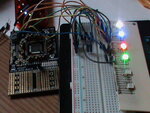Hawk44
Newbie level 6
Just joined the forum, need some help.
I am using MPLAB 8, C18, and learning to program. I am using a PIC18F45K20 ic.
My code is a little messed up in that I have been trying different things found on the web.
I have gone through the Data sheet and it is confusing when attempting to see what relates to
what with RA0, etc. I am trying to just blink an LED off/on with the ports A. Would like to use all of
them eventually. Sure would like some help, so I can keep on learning, but I am sort of stuck now.
I am also using the demo board for the 18F45K20.
The LED's work fine on portD, But check with voltmeter shows no change on portA, When I move LED to port D, works fine. I conclude that my code is at fault. Perhaps not setting the port A to digital. Changed PBADEN = OFF //disable the analog inputs on RB0 through RB4, but didn't see anything simular for port A.
Here is my code:
Thank you in advance
David :-D
I am using MPLAB 8, C18, and learning to program. I am using a PIC18F45K20 ic.
My code is a little messed up in that I have been trying different things found on the web.
I have gone through the Data sheet and it is confusing when attempting to see what relates to
what with RA0, etc. I am trying to just blink an LED off/on with the ports A. Would like to use all of
them eventually. Sure would like some help, so I can keep on learning, but I am sort of stuck now.
I am also using the demo board for the 18F45K20.
The LED's work fine on portD, But check with voltmeter shows no change on portA, When I move LED to port D, works fine. I conclude that my code is at fault. Perhaps not setting the port A to digital. Changed PBADEN = OFF //disable the analog inputs on RB0 through RB4, but didn't see anything simular for port A.
Here is my code:
Code C - [expand]
Thank you in advance
David :-D
Last edited by a moderator:


